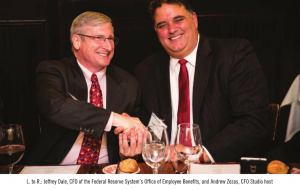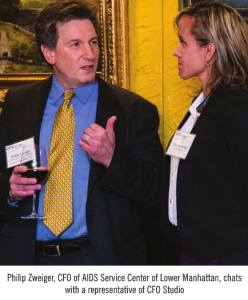As Seen in CFO Studio Magazine Q1/Q2 2016 Issue
EVERY GENERATION MUST GET SOME NEEDS SATISFIED 
There’s nothing easy about creating a package of employee benefits that will attract the kind of talent most companies seek and will be competitive with the offerings of aggressive and best-in-class employers that vie for high-potential employees. CFOs who recently attended a Middle Market Companies CFO Dinner, part of CFO Studio’s Executive Dinner Series, at Sparks Steakhouse in Manhattan, were not so much looking for answers as they were looking to identify differences between the workforce of today and the workforce they’d assumed they’d be leading.
Discussion leader Jeffrey Dale, Chief Financial Officer of the Federal Reserve System’s Office of Employee Benefits in Newark, NJ, who provides a variety of benefits to approximately 22,000 active employees and 25,000 retirees, said in an interview, “What interested me about the [dinner] discussion was how laser-focused the group was on Millennials, and that we had much less conversation about the different groups that also make up a lot of the employment demographic.”
He noted that motivating Millennial employees and candidates is “clearly an issue that everyone is struggling with. Even defining the attributes of a Millennial is a lot harder than we might think.”
One CFO of a tax-exempt organization said Millennials, in his experience, are often motivated by money and vacation time. Another CFO said: “I don’t know if Millennials care as much about making money as they do about making a difference.”
Some Millennials run out the door at 4:00 p.m. to get to the gym but log back in at 10:00 p.m. and work until 2:00 a.m. One CFO stated that Millennials see sacrifices their parents made and seek more work/life balance. And a CFO in a family business said his Millennial employees, many of them truck drivers and mechanics, work 70 hours a week.
AnnMarie Santamarina, Managing Partner of Tahas Technologies, a full-service IT consulting company and a CFO Studio Business Development Partner, said that as the workforce changes, benefit expectations are also shifting. “We find ourselves reevaluating our offerings to suitably address all employees, instigating a culture discussion for us [at Tahas]. Ms. Santamarina said that in the end, Tahas leadership is providing a defined culture for its employees, and the benefits to support that, where people can balance their work and life priorities. Her hope is “to foster an environment where employees are able to focus on the work that’s in front of them while also being able to address whatever they have going on outside of the office — and for each employee, that part will be different.”
 Mr. Dale encouraged everyone to think through the topic at the end of the evening and consider what they might do differently as a result of the idea exchange. In a follow-up interview he said that he had done just that, sharing what he’d learned from the CFO guests who spoke of motivating factors for the younger members of their workforce. He encouraged a staff member who works on plan design to “factor that into” the Federal Reserve’s benefits design. At the same time, he said, “We do need to consider the different employment audiences, not just the Millennials.”
Mr. Dale encouraged everyone to think through the topic at the end of the evening and consider what they might do differently as a result of the idea exchange. In a follow-up interview he said that he had done just that, sharing what he’d learned from the CFO guests who spoke of motivating factors for the younger members of their workforce. He encouraged a staff member who works on plan design to “factor that into” the Federal Reserve’s benefits design. At the same time, he said, “We do need to consider the different employment audiences, not just the Millennials.”
An important issue discussed among CFO guests was the need to ensure data integrity when workers’ needs and expectations require working from home, client sites, hotel rooms, airports, and just about anywhere else. Ms. Santamarina said the concepts of mobility and data integrity intersect at the point where the employee, the data (a company asset), and the flexibility that the employer wants to provide, come together. “This is a challenge both for Tahas and for our clients. Tahas focuses on solutions that provide the right amount of mobile flexibility while ensuring the optimal layers of security are in place to protect a firm’s valuable asset, their data,” she said.
The dinner conversation took a philosophical turn when Mr. Dale commented that younger staff members in the Federal Reserve’s employ “don’t know much about the defined benefit retirement plan, except that it exists. Our challenge is to get that younger person to focus on the value of that benefit long-term. There is a social good in educating young people in our employ,” Mr. Dale continued, “providing financial education and tools” to help them prepare for their financial future and specifically, retirement.
The slate of benefits that companies provide has seen some updating in the digital age, to attract workers in an era of fast-paced change. The paternalistic employer is gone, replaced by a company that morphs and acquires other companies, adding and shedding jobs as needed. It may be that Millennials are very different from the workers of 20 years ago, but so are the companies that employ them.

